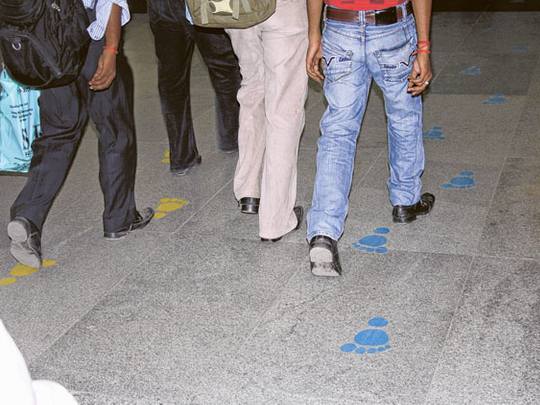
New Delhi: After nine years of successful run, serving New Delhi, Noida, Ghaziabad and Gurgaon, the Delhi Metro is now preparing to give lessons to metros in other parts of the world.
The Delhi Metro Rail Corporation (DMRC) officials recently came up with an innovative idea for several confused commuters. Many uneducated commuters, who were unable to understand the signages, can now track their way to the right station through footprints.
The colour-coded footprints on the floors at busy interchange Metro stations were imprinted after the authorities were flooded with complaints. Commuters complained about difficulty in identifying the right platforms and boarded the wrong trains.
Illiterate
Remarked Kailash Bhatt, a worker from Rajasthan, "I had a harrowing experience last month, when I rushed to get to my destination, I boarded the wrong train. It took more time and penalty to explain to the security officials at the Rajiv Chowk station about the goof up."
Bhatt was, however, recently surprised to find his way easily through footprints. "The introduction of footprints is a trouble-free affair and such a blessing at the busy interchange stations," he said.
A DMRC official detailed, "To catch a Metro on the red line (Line 1), a commuter has to follow the red-coloured footprints. Similarly, for Line 2 it is the yellow coloured footprints, blue ones for Line 3-4, green colour for Line 5 and violet colour footprints for Line 6."
The footprints have been pasted at all interchange stations — Rajiv Chowk, Central Secretariat, Kashmere Gate, Yamuna Bank, Kirti Nagar and Ashok Park.
The official said, "We have got a very positive feedback. Many regular commuters said that sometimes even they used to get confused earlier. And while trying to find their desired platform, would get late for office. People are now getting into the habit of following the colour that denotes the line."
Delhi Metro is considered the largest metro networks in the world, consisting of six lines with more than 140 stations of which 35 are underground. Out of these, the Rajiv Chowk station in Central Delhi is considered the busiest station providing interchange opportunities between Line 2 and Line 3.
Enthused by the public response, the officials are considering similar procedures at other interchange stations in Phase 3. These would include, Azadpur, Punjabi Bagh, Lajpat Nagar, Mayur Vihar, Hauz Khas and Mandi House.
Park and museum
Delhi Metro has time and again come up with exemplary ideas, including developing the Central Park, around which the entire Connaught Place market is layered.
It also boasts of the only one of its kind Metro Museum that showcases the history and journey of DMRC. Focusing on the recreational field, it has now planned an amusement park for children.












